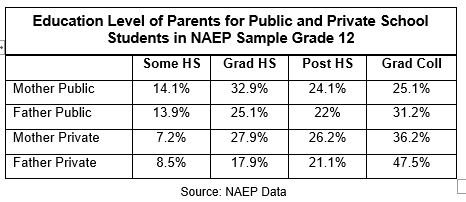In California and elsewhere, there are big fights going on about vouchers--using public money to send kids to private and parochial schools. Many of the issues get to be very complicated. For example, to what extent, if at all, should private schools accepting taxpayers' money be regulated? And will vouchers save money or cost billions? So voters trying to decide about California's Proposition 174 are faced with lots of conflicting and confusing analysis about the results of passing this initiative.
But voucher supporters have now come up with a simple argument that they consider a clincher. They say that all you have to do is look at the huge number of public school teachers who send their kids to private schools. The figure bandied about is 40 or sometimes 50 percent of teachers, in comparison with about only 12 to 14 percent of the American public as a whole. If public school teachers are not willing to trust their children to public schools, voucher supporters ask, why should other parents be? The Wall Street Journal summarized this argument in the headline of an October 25 editorial: "Teacher Knows Best" (undoubtedly the first time in memory that the Wall Street Journal ever thought this).
Now, if the 40 percent figure were accurate, you'd have to take it seriously, even if there were complicating factors, like finding that teachers were disproportionately Catholic and sending their kids to parochial schools for religious reasons. But the figure turns out to be totally wrong.
It's what Gerald Bracey, writing in Education Week (September 29,1993), calls an urban legend--a tall tale, like the one about the alligators in New York City sewers or the jumping bean in the diet pill, that gains wide acceptance simply because it is too intriguing and horrifying not to be true.
In fact, there are a number of studies and surveys showing that the percentage of public school teachers who send their children to private schools is nothing like 40 percent. According to a Metropolitan Life survey conducted by Louis Harris in 1984, 14 percent of public school teachers nationwide send their children to private schools as opposed to 12 percent of the general public.
A study of 1980 U.S. Census data from 12 states (not necessarily representative of the entire country) is generally consistent with the Metropolitan Life survey. On the other hand, surveys done by the Gallup organization for the National Education Association (NEA) between 1986 and 1989 found numbers that were considerably lower: 8 to 10 percent of teachers as a whole and 10 to 14 percent of urban teachers send their youngsters to private schools.
The above figures show that teachers do not send their kids to private schools on a vastly different scale from other U.S. parents, as is claimed by the Wall Street Journal, William Bennett and George Will. Furthermore, when teachers are compared with other college graduates--in other words, with people at the same education and income levels--it becomes clear that they send their kids to private schools less often than other people of comparable socioeconomic status. As data gathered by the National Assessment of Educational Progress (NAEP) show (see table), the higher the education level, the more likely parents are to send kids to private schools and vice versa. Considering that about 12 percent of parents in the general population send their youngsters to private schools--and this figure includes parents who are dropouts and high school graduates only--you would expect the percentage of teachers, all of whom are college graduates, to be far higher than it is--perhaps even 40 percent, instead of a figure down in the teens. So, far from abandoning the public schools, public school teachers send their children in much greater numbers than other parents with comparable education levels--and of course, as the Wall Street Journal says, "Teacher knows best."
But even if we had no Gallup Polls or census or NAEP figures, there would be a surefire way of knowing whether huge numbers of teachers have their kids in private schools. These people are all members of AFT and NEA, and if 40 or 50 percent had a chance of getting a $2,600 voucher, you can be sure the unions would be in political turmoil. These teachers, many of whom have been under salary freezes for a number of years and have had to accept contract givebacks, would be demanding that the union support vouchers for their kids.
Teachers spend a good part of their lives in schools and know them well, so the logic of the people who devised this indicator was strong. However, their numbers are way off. It will be interesting to see whether they will continue to embrace the logic of their argument or keep reiterating their faulty numbers.

